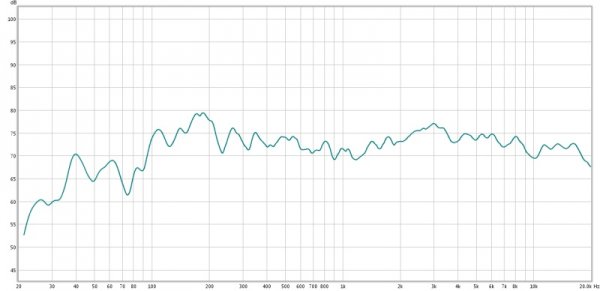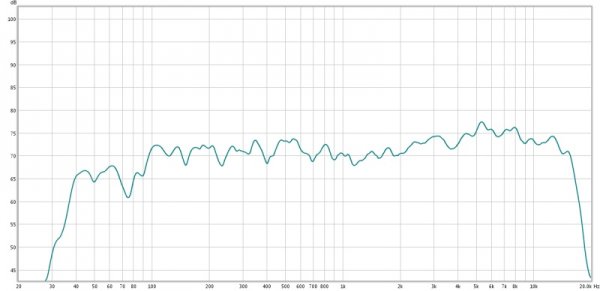How flat should the frequency response be in a room?
- Thread starter caesar
- Start date
You are using an out of date browser. It may not display this or other websites correctly.
You should upgrade or use an alternative browser.
You should upgrade or use an alternative browser.
There was a paper I read.... think it was from Sean Olive and someone else that gave good starting points.
How flat should the frequency response be in a room?
Although IMHO the question is being formulated in a too general way, I would say it will depend on your priorities. However for a fast start you can read the guidelines of Nyal Mellor of Acoustic Frontiers http://www.acousticfrontiers.com/audio-projects-acoustic-design/. We had a nice thread on it at WBF.
Depends what you aim for , My FI or High FI .
For My Fi you might want some mysterious (Dark art) response , the High Fyers go for the flat lines , although I prefer a little tilted slope from 200/300 hz on lower.
, although I prefer a little tilted slope from 200/300 hz on lower.
This could be because microphones in general have difficulties to accurately record low freqs , the LS /room excess might compensate that a little
IMO ,a NOT neutral response gets boring quite quickly , a main culprit of so called listening fatique
For My Fi you might want some mysterious (Dark art) response , the High Fyers go for the flat lines
This could be because microphones in general have difficulties to accurately record low freqs , the LS /room excess might compensate that a little
IMO ,a NOT neutral response gets boring quite quickly , a main culprit of so called listening fatique
Last edited:
Definitely "My Fi" for me. I'm listening for pleasure, I'm not working on a track. I like some bass lift 2 to 4dB at 20Hz sloped down then pretty flat from 300Hz to 2kHz and a downslope there by 2dB to above 20kHz. That's just me and how I like it. I'll take a dip over a hump if I had no choice in the matter.
However for a fast start you can read the guidelines of Nyal Mellor of Acoustic Frontiers http://www.acousticfrontiers.com/audio-projects-acoustic-design/. We had a nice thread on it at WBF.
That's the paper I was trying to remember. Great read....
"Flat" needs a definition otherwise it's impossible to say yes or no to it. Here's my definition of flat:
Consistent frequency response, within 2-5db (at least 1/12 octave smoothing) across the spectrum, and good impulse response as well, from multiple 3D points inside the listening area tailored to the listener's preferences. The definition must include both frequency and time info because time can affect perceived frequency response.
Consistent frequency response, within 2-5db (at least 1/12 octave smoothing) across the spectrum, and good impulse response as well, from multiple 3D points inside the listening area tailored to the listener's preferences. The definition must include both frequency and time info because time can affect perceived frequency response.
Last edited:
"Flat" needs a definition otherwise it's impossible to say yes or no to it. Here's my definition of flat:
Consistent frequency response, within 2-5db (at least 1/12 octave smoothing) across the spectrum, and good impulse response as well, from multiple 3D points inside the listening area tailored to the listener's preferences. The definition must include both frequency and time info because time can affect perceived frequency response.
"At Least" 1/12 octave smoothing?? That's ONE NOTE in the chromatic scale. Why would you need 1/24 or 1/36 octave. All you will see with that on the graph is a mess of squiggly lines resulting from comb filtering that really won't tell you anything useful about your room, besides, you'll get a different graph if you move the microphone an inch or two. It may even obscure what you want to see in your graph. This is a case where a little less is more.
I think the 1/12 octave smoothing you mentioned is actually ideal.
Last edited:
I agree but it will be impossible for most folks to achieve that type of linearity down to 20hz without DSP or EQ. Room non-linearity doesn't follow the musical scale; peaks and dips in between notes. Unsmoothed measurements are ideal for DSP. In addition, it's always best to take multiple measurements in a 3d space within the listening field and then combine those measurements. Taking a single sweep will produce an inaccurate measurement every time. All of those should be taken unsmoothed before they are combined into a single magnitude response. That's why I say, at least.
I've seen a reviewer say all audiophiles should use a mic to measure. He criticizes folks for being measurement averse. Yet, he only posts 1/3 smoothed FR for his "music vault." That's silly.
I've seen a reviewer say all audiophiles should use a mic to measure. He criticizes folks for being measurement averse. Yet, he only posts 1/3 smoothed FR for his "music vault." That's silly.
"At Least" 1/12 octave smoothing?? That's ONE NOTE in the chromatic scale. Why would you need 1/24 or 1/36 octave. All you will see with that on the graph is a mess of squiggly lines resulting from comb filtering that really won't tell you anything useful about your room, besides, you'll get a different graph if you move the microphone an inch or two. It may even obscure what you want to see in your graph. This is a case where a little less is more.
I think the 1/12 octave smoothing you mentioned is actually ideal.
Last edited:
I agree that you need several room position measurements.
When you use 1/12 octave smoothing, it doesn't matter if the discrepancy is between notes or right on the note. It is extremely close to the offending frequency either way and with higher resolution, all you get is comb filtering a few Hz in one direction or the other from the preceding measurement.
When you use 1/12 octave smoothing, it doesn't matter if the discrepancy is between notes or right on the note. It is extremely close to the offending frequency either way and with higher resolution, all you get is comb filtering a few Hz in one direction or the other from the preceding measurement.
As far as I read, the smoothing you choose depends on the zone of the spectrum you are considering and what is the purpose of the measurement. As a rule of thumb some people advise to use 1/24 octave bellow the Schroeder frequency and 1/6 octave above it. The 1/3 octave is useful just to get an image of the general tilt of the room.
Ok from what I read 1/3 represents about where we hear, so wouldn't you want to use that? Or 1/6 to expose a few hidden bumps and dips that the 1/3 wouldn't show?
It depends. You would want unsmoothed for certain things like DSP operations. You would also want unsmoothed to help find exact location of boundary interference and even better seat/speaker position. That's how I would use it. OTOH, 1/12 octave is all one really needs to generally describe system accuracy to determine whether they have achieved their goal of linearity or to generally show someone else that's interested in their system response. However, no magnitude response alone can fully describe how a system sounds. (That was for Myles). However, crappy response does mean a system is subpar for sure. My point is that you can hide a lot of warts in a 1/3 per octave smoothed graph that are very audible even if it's better than a previous 1/3 octave graph.
Ok from what I read 1/3 represents about where we hear, so wouldn't you want to use that? Or 1/6 to expose a few hidden bumps and dips that the 1/3 wouldn't show?
What you said about hiding warts is exactly why I use 1/6 I think it shows enough to get the job done in most rooms.
It depends. You would want unsmoothed for certain things like DSP operations. You would also want unsmoothed to help find exact location of boundary interference and even better seat/speaker position. That's how I would use it. OTOH, 1/12 octave is all one really needs to generally describe system accuracy to determine whether they have achieved their goal of linearity or to generally show someone else that's interested in their system response. However, no magnitude response alone can fully describe how a system sounds. (That was for Myles). However, crappy response does mean a system is subpar for sure. My point is that you can hide a lot of warts in a 1/3 per octave smoothed graph that are very audible even if it's better than a previous 1/3 octave graph.
It looks like there's loss of energy between 65hz and 100hz.
The problem with smoothing even at 1/6 is that you can't really see whether there's a true boundary interference contributing to that loos of energy or something else. With unsmoothed, an SBIR dip will be very obvious. If an SBIR is really there, then you can use math to figure out which boundary is causing the SBIR.
The problem with smoothing even at 1/6 is that you can't really see whether there's a true boundary interference contributing to that loos of energy or something else. With unsmoothed, an SBIR dip will be very obvious. If an SBIR is really there, then you can use math to figure out which boundary is causing the SBIR.
Here are two examples of my room, one is flat the other is after some eq. The target is 72db in the eq measurement, this is just the mains no sub.
The problem with smoothing even at 1/6 is that you can't really see whether there's a true boundary interference contributing to that loos of energy or something else. With unsmoothed, an SBIR dip will be very obvious. If an SBIR is really there, then you can use math to figure out which boundary is causing the SBIR.
And what would that look like as opposed to a room modal issue?
It would be a very narrow V shape, assuming the boundary is a bare wall or concrete floor; something solid and untreated. This also assumes we are only looking at a single listening position measurement.And what would that look like as opposed to a room modal issue?
It would be a very narrow V shape, assuming the boundary is a bare wall or concrete floor; something solid and untreated. This also assumes we are only looking at a single listening position measurement.
and then how is this measured in the time domain so you can find the boundary?
Similar threads
- Replies
- 68
- Views
- 4K
- Replies
- 9
- Views
- 524
- Replies
- 14
- Views
- 621
Staff online
-
treitz3Super Moderator
Members online
- hesavary
- yyzSB
- Argonaut
- andromedaaudio
- Blake
- Geoffkait
- R Johnson
- dcathro
- tapepath
- Don Reid
- treitz3
- dan31
- bonzo75
- blackswan
- GroovySauce
- aLLeARS
- GSOphile
- bozebuttons
- Mike Lavigne
- remdeck
- Jpowell
- jadis
- iain
- Mobiusman
- Robh3606
- Rooneydog
- seatrope
- fbs
- jazzdude99
- audiom3
- Vangelis
- VPN
- kswanson27
- Golum
- Hilroy48
- Pichler
- trekpilot
- Labpro
- kmyl
- flowcharts
- willgall
- Achilles
- TST
- mikem
- mtemur
- Gregadd
- DonH50
- J007B
- 108CY
- matthias
Total: 1,359 (members: 69, guests: 1,290)
| Steve Williams Site Founder | Site Owner | Administrator | Ron Resnick Site Co-Owner | Administrator | Julian (The Fixer) Website Build | Marketing Managersing |



